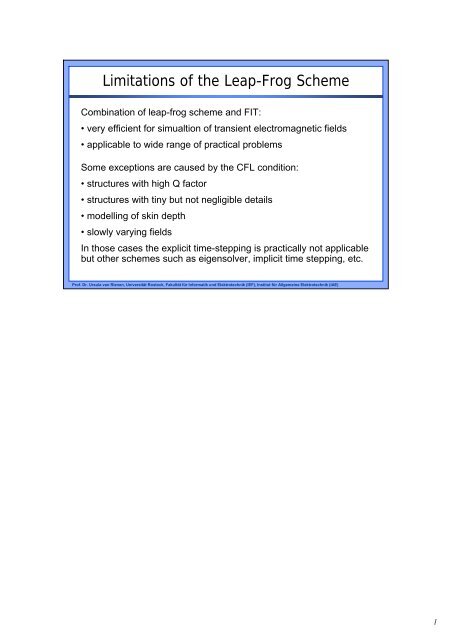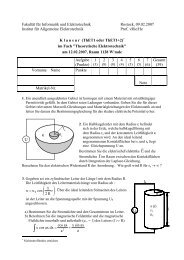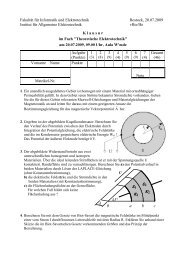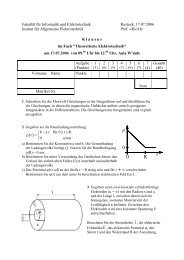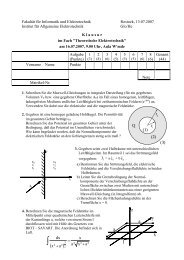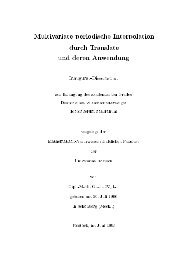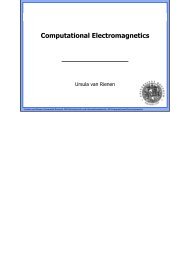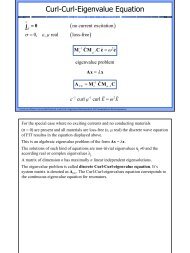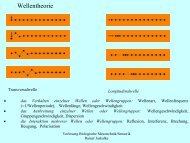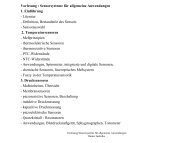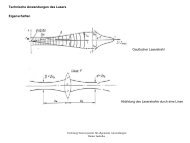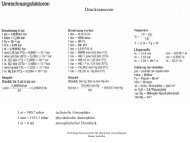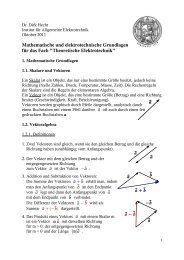Institut für Allgemeine Elektrotechnik, Uni Rostock - Universität ...
Institut für Allgemeine Elektrotechnik, Uni Rostock - Universität ...
Institut für Allgemeine Elektrotechnik, Uni Rostock - Universität ...
Create successful ePaper yourself
Turn your PDF publications into a flip-book with our unique Google optimized e-Paper software.
Limitations of the Leap-Frog Scheme<br />
Combination of leap-frog scheme and FIT:<br />
• very efficient for simualtion of transient electromagnetic fields<br />
• applicable to wide range of practical problems<br />
Some exceptions are caused by the CFL condition:<br />
• structures with high Q factor<br />
• structures with tiny but not negligible details<br />
• modelling of skin depth<br />
• slowly varying fields<br />
In those cases the explicit time-stepping is practically not applicable<br />
but other schemes such as eigensolver, implicit time stepping, etc.<br />
Prof. Dr. Ursula van Rienen, <strong>Uni</strong>versität <strong>Rostock</strong>, Fakultät <strong>für</strong> Informatik und <strong>Elektrotechnik</strong> (IEF), <strong>Institut</strong> <strong>für</strong> <strong>Allgemeine</strong> <strong>Elektrotechnik</strong> (IAE)<br />
1
Limitations of the Leap-Frog Scheme<br />
What is the Q factor?<br />
Q factor plays an important role for resonators, filters, etc.<br />
It gives the relation between stored energy and the power loss in<br />
the walls:<br />
ωW<br />
Q = P<br />
with the stored energy of the time-harmonic field in volume V<br />
v<br />
1 1<br />
W = εr<br />
* dV μr<br />
* dV<br />
2∫<br />
E⋅ E = ⋅<br />
2∫<br />
H H<br />
V<br />
and the power loss, i.e. Ohmic losses by wall currents<br />
1 J⋅<br />
J* 1 ωμ<br />
Pv = dV<br />
t t<br />
* dA<br />
2∫<br />
= ⋅<br />
σ 2 2σ∫H<br />
H<br />
V<br />
Prof. Dr. Ursula van Rienen, <strong>Uni</strong>versität <strong>Rostock</strong>, Fakultät <strong>für</strong> Informatik und <strong>Elektrotechnik</strong> (IEF), <strong>Institut</strong> <strong>für</strong> <strong>Allgemeine</strong> <strong>Elektrotechnik</strong> (IAE)<br />
2
TESLA Cavity<br />
Photo/graphic:<br />
DESY Hamburg<br />
www.linearcollider.org<br />
ILC will use 16,000 superconducting cavities to<br />
accelerate electrons and positrons to 99.9999999998<br />
percent of the speed of light.<br />
Prof. Dr. Ursula van Rienen, <strong>Uni</strong>versität <strong>Rostock</strong>, Fakultät <strong>für</strong> Informatik und <strong>Elektrotechnik</strong> (IEF), <strong>Institut</strong> <strong>für</strong> <strong>Allgemeine</strong> <strong>Elektrotechnik</strong> (IAE)<br />
3
Limitations of the Leap-Frog Scheme<br />
1. Structures with high quality factor (resonators, filter, ...):<br />
ω ⋅ Ws<br />
frequency × stored energy<br />
Quality factor Q is defined as Q = =<br />
Pv<br />
losses<br />
⎧long decay time of resonant oscillation<br />
High Q → ⎨<br />
⎩ long rise time<br />
of<br />
the fields<br />
4<br />
Example: resonator with copper walls typically has Q ≈7 ⋅10<br />
Q<br />
4<br />
⇒ only after ≈10 periods the stored energy decayed to<br />
2π<br />
about 37% of it's initial value<br />
For a typical discretization and 20 time<br />
steps per period this means<br />
5<br />
that more than 10 time integrations would be necessary<br />
Long<br />
computation time<br />
in time domain → usually frequency domain<br />
is chosen in such cases<br />
Prof. Dr. Ursula van Rienen, <strong>Uni</strong>versität <strong>Rostock</strong>, Fakultät <strong>für</strong> Informatik und <strong>Elektrotechnik</strong> (IEF), <strong>Institut</strong> <strong>für</strong> <strong>Allgemeine</strong> <strong>Elektrotechnik</strong> (IAE)<br />
4
Limitations of the Leap-Frog Scheme<br />
2. Modelling of small geometrical details:<br />
Functions of the grid: i) sampling the wave in space and time<br />
ii) map the material distribution to discrete space<br />
Difficulty if ratio of wavelength to geometrical detail is large:<br />
over-sampling<br />
of the wave in space and time<br />
Example : Plane wave of 30 MHz (wavelength ≈ 10 m) incident<br />
on perfect conductor with surface details in<br />
mm-range<br />
Δ x = Δ y = Δz ≈ Δt<br />
≈ ⋅<br />
−12<br />
For 1mm we get 2 10 s from CFL<br />
−8<br />
For a period of 3,3 10 s we would need more<br />
T<br />
≈<br />
than 17,000 time steps per period!<br />
This leads to an enormous computational effort why subgrids or<br />
a<br />
conformal approach are used then.<br />
⋅<br />
Prof. Dr. Ursula van Rienen, <strong>Uni</strong>versität <strong>Rostock</strong>, Fakultät <strong>für</strong> Informatik und <strong>Elektrotechnik</strong> (IEF), <strong>Institut</strong> <strong>für</strong> <strong>Allgemeine</strong> <strong>Elektrotechnik</strong> (IAE)<br />
5
Limitations of the Leap-Frog Scheme<br />
3. Skin depth modelling:<br />
Skin depth of good conductors wave length in free space<br />
To sample the exponential field decay inside the conductors<br />
a sufficiently fine grid is needed which in turn leads to extremely<br />
small time steps and thus to a strong loss in efficiency<br />
Solution: special layer models<br />
for skin depth without discretization<br />
Prof. Dr. Ursula van Rienen, <strong>Uni</strong>versität <strong>Rostock</strong>, Fakultät <strong>für</strong> Informatik und <strong>Elektrotechnik</strong> (IEF), <strong>Institut</strong> <strong>für</strong> <strong>Allgemeine</strong> <strong>Elektrotechnik</strong> (IAE)<br />
6
Limitations of the Leap-Frog Scheme<br />
4. Slowly varying fields ("low-frequency fields", Quasistatics):<br />
wavelength<br />
dimension<br />
(e.g. motors or generators at 50 Hz)<br />
i incident field in conductor has to be modelled by discretization<br />
i matei<br />
r als often non-linear<br />
Example: Copper cube of 10 cm side length inside of cubic<br />
grid of d = 1m side length and uniform step size of 5 mm;<br />
7<br />
conductivity 5.8 ⋅10 S/m, applied alternating current of 50 Hz<br />
⇒ skin depth of δ = 2 / ( ωµ<br />
κ)<br />
≈1cm while vacuum wave<br />
6<br />
length is λ = c / f ≈ 6 ⋅10 m 1 m (grid size).<br />
For the time integration of one period T = 0.02 s the maximal<br />
−12 9<br />
stable time step is Δtmax<br />
≈9.6 ⋅10 s affording 2⋅10 t<br />
Solution:<br />
Implicite time integration scheme<br />
Prof. Dr. Ursula van Rienen, <strong>Uni</strong>versität <strong>Rostock</strong>, Fakultät <strong>für</strong> Informatik und <strong>Elektrotechnik</strong> (IEF), <strong>Institut</strong> <strong>für</strong> <strong>Allgemeine</strong> <strong>Elektrotechnik</strong> (IAE)<br />
ime steps!<br />
7
Initial Value Problem of Time Domain<br />
For stability studies we regard a single system of differential equations:<br />
d<br />
y= Ay+ q, y( 0 )<br />
= y<br />
t=<br />
t<br />
dt<br />
representing the discrete Faraday's and Ampere's law.<br />
initial value problem of the time domain formulation of FIT with:<br />
<br />
⎛<br />
0<br />
−1<br />
h⎞<br />
⎛ −M<br />
C⎞<br />
µ<br />
solution vector: y= ⎜<br />
⎟, system matrix: A= ⎜ −1 −1<br />
⎝e⎠ ⎟<br />
⎝Mε C<br />
Mε Mσ<br />
⎠<br />
( 0)<br />
source vector:<br />
⎛ 0 ⎞<br />
q= , initial value:<br />
y<br />
⎜ −1<br />
− ⎟<br />
⎝ Mε<br />
jS<br />
⎠<br />
( t = t )<br />
0<br />
= y<br />
( 0)<br />
Prof. Dr. Ursula van Rienen, <strong>Uni</strong>versität <strong>Rostock</strong>, Fakultät <strong>für</strong> Informatik und <strong>Elektrotechnik</strong> (IEF), <strong>Institut</strong> <strong>für</strong> <strong>Allgemeine</strong> <strong>Elektrotechnik</strong> (IAE)<br />
8
Properties of the System Matrix<br />
( σ = ⇒ M = )<br />
In the loss-free case 0 0<br />
similarity transformation<br />
A'<br />
−1/2 1/2<br />
⎛ ⎞ ⎛ ⎞<br />
−1 −1<br />
µ µ<br />
= ⎜ ⎟ A ⎜ ⎟<br />
to transform A to the real skew-symmetric matrix A'<br />
⎛<br />
A'<br />
= ⎜<br />
⎜M<br />
⎝<br />
M 0 M 0<br />
⎜ 1/2 ⎟ ⎜ −1/2<br />
⎟<br />
⎝ 0 Mε<br />
⎠ ⎝ 0 Mε<br />
⎠<br />
0 −M CM<br />
−1/2<br />
T 1/2<br />
ε<br />
CM 0<br />
1<br />
µ −<br />
with identical spectrum.<br />
1/2 −1/2<br />
−1<br />
µ ε<br />
⎞<br />
⎟<br />
⎟<br />
⎠<br />
σ<br />
we may apply the<br />
Prof. Dr. Ursula van Rienen, <strong>Uni</strong>versität <strong>Rostock</strong>, Fakultät <strong>für</strong> Informatik und <strong>Elektrotechnik</strong> (IEF), <strong>Institut</strong> <strong>für</strong> <strong>Allgemeine</strong> <strong>Elektrotechnik</strong> (IAE)<br />
9
Properties of the System Matrix<br />
Properties of the system matrix:<br />
i All eigenvalues of A lie on the imaginary axis.<br />
λ A ,i<br />
They are either 0 or complex-conjugate in pairs.<br />
i A complete basis of eigenvectors exists.<br />
Eigenvectors of different eigenvalues are orthogonal.<br />
A simple estimate for the absolute largest eigenvalue ω<br />
yields ω<br />
max<br />
≤ A' for any arbitrary matrix norm.<br />
= max λ<br />
max A,i<br />
Example: µ ≡ µ , ε ≡ε<br />
, Δ u = Δ v = Δ w = Δ yields :<br />
0 0<br />
1 ⎛0 −C⎞<br />
4c<br />
A' = ⎜ ⎟ ⇒ A' = A'<br />
=<br />
∞ 1<br />
µ<br />
0ε<br />
Δ<br />
0Δ ⎝C 0 ⎠<br />
0<br />
Prof. Dr. Ursula van Rienen, <strong>Uni</strong>versität <strong>Rostock</strong>, Fakultät <strong>für</strong> Informatik und <strong>Elektrotechnik</strong> (IEF), <strong>Institut</strong> <strong>für</strong> <strong>Allgemeine</strong> <strong>Elektrotechnik</strong> (IAE)<br />
10
Properties of the System Matrix<br />
Generally, the following estimate may be used:<br />
Cell i : Δ u ×Δ v ×Δw with ε , µ<br />
ω<br />
max<br />
≤<br />
i ì i i i<br />
2 1 1 1<br />
ωi<br />
= + +<br />
ε µ Δu Δv Δw<br />
max<br />
i<br />
( ω )<br />
i<br />
i<br />
2 2 2<br />
i i i<br />
In the lossy case similar estimates are possible:<br />
{ i}<br />
{ }<br />
− MM ≤ Re ≤0<br />
−1<br />
σ ε<br />
λ<br />
−ω ≤ Im λ ≤ω<br />
max i max<br />
Prof. Dr. Ursula van Rienen, <strong>Uni</strong>versität <strong>Rostock</strong>, Fakultät <strong>für</strong> Informatik und <strong>Elektrotechnik</strong> (IEF), <strong>Institut</strong> <strong>für</strong> <strong>Allgemeine</strong> <strong>Elektrotechnik</strong> (IAE)<br />
11
Recursive Time Integration Method<br />
Formal solution of the initial value problem:<br />
()<br />
( 0)<br />
( ( ) ( ))<br />
y t = y + Ay t' + q t' dt'<br />
Prof. Dr. Ursula van Rienen, <strong>Uni</strong>versität <strong>Rostock</strong>, Fakultät <strong>für</strong> Informatik und <strong>Elektrotechnik</strong> (IEF), <strong>Institut</strong> <strong>für</strong> <strong>Allgemeine</strong> <strong>Elektrotechnik</strong> (IAE)<br />
∫<br />
t<br />
t<br />
0<br />
Exact solution of these large systems (complete decomposition in<br />
eigenvector basis or exponential matrix of A) not possible in<br />
practical applications. Therefore: recursive solution. We distinguish:<br />
i explicite<br />
and implicite recursion, depending on the formula for a<br />
new value: explicite or affording to solve an equation or a system<br />
of equations<br />
i single and multi ple step method s, depending<br />
on the number of<br />
old values taken into account. Linear single step methods may be<br />
( m + 1) ( m ) ( m )<br />
written as y = Gy + q with the recursion matrix G.<br />
12
Stability<br />
Stability is one of the most important properties of a numerical<br />
integration scheme.<br />
( Δt)<br />
The linear recursion operator G depends on Δt.<br />
Several slightly different definitions can be found for the term "stability" ,<br />
the following plays an important role in convergence analysis.<br />
Definition by Lax-Richtmeyer:<br />
( m+<br />
)<br />
Δ<br />
(<br />
t0<br />
><br />
) ( m<br />
t<br />
) 1<br />
( t)<br />
Prof. Dr. Ursula van Rienen, <strong>Uni</strong>versität <strong>Rostock</strong>, Fakultät <strong>für</strong> Informatik und <strong>Elektrotechnik</strong> (IEF), <strong>Institut</strong> <strong>für</strong> <strong>Allgemeine</strong> <strong>Elektrotechnik</strong> (IAE)<br />
( m)<br />
A recursion y = G Δ y is stable<br />
if a constant C and<br />
a value 0 exist for each (fixed) value T such that<br />
holds.<br />
( ) ( m)<br />
G Δ ≤C<br />
∀m⋅Δt ≤T and Δt < Δt<br />
i.e. G Δt remains bounded for Δt →0 and constant T ( m →∞).<br />
0<br />
13
A sufficient stability<br />
condition is<br />
G<br />
( Δt<br />
) ≤1<br />
( ∀Δt<br />
)<br />
since this also involves<br />
m<br />
( t) G( t)<br />
G Δ ≤ Δ ≤1.<br />
Then, for y<br />
y<br />
Stability<br />
( Δt<br />
) ≤ ( ∀Δt<br />
)<br />
G( Δt<br />
)<br />
A sufficient condition for G 1<br />
λ<br />
G<br />
≤ 1<br />
( m)<br />
m<br />
we get<br />
( m) ( m−1) m ( 0) m ( 0) ( 0)<br />
= Gy = … = G y ≤ G ⋅ y ≤<br />
i.e. the solution norm stays bounded (note: no excitation assumed!)<br />
for all eigenvalues of<br />
different recursion methods w.r.t. their stabilty.<br />
i<br />
y<br />
,<br />
is<br />
. It may be used to study<br />
Prof. Dr. Ursula van Rienen, <strong>Uni</strong>versität <strong>Rostock</strong>, Fakultät <strong>für</strong> Informatik und <strong>Elektrotechnik</strong> (IEF), <strong>Institut</strong> <strong>für</strong> <strong>Allgemeine</strong> <strong>Elektrotechnik</strong> (IAE)<br />
14
Stability of Some Recursion Methods<br />
The three most simple time integration schemes are based on<br />
approximating the time derivative by:<br />
1. forward difference quotient:<br />
2. backward difference quotient:<br />
3. central difference quotient:<br />
(constant time step Δt)<br />
( )<br />
f<br />
t<br />
0<br />
( + Δt ) − f ( t )<br />
0 0<br />
f ( t0)<br />
f t0<br />
f − ( − Δt<br />
)<br />
( t ) ≈<br />
0<br />
( )<br />
f<br />
t<br />
0<br />
f t<br />
≈<br />
f t<br />
≈<br />
Δt<br />
Δt<br />
( + Δt<br />
/2) − f ( t −Δt<br />
/2)<br />
0 0<br />
Δt<br />
Prof. Dr. Ursula van Rienen, <strong>Uni</strong>versität <strong>Rostock</strong>, Fakultät <strong>für</strong> Informatik und <strong>Elektrotechnik</strong> (IEF), <strong>Institut</strong> <strong>für</strong> <strong>Allgemeine</strong> <strong>Elektrotechnik</strong> (IAE)<br />
15
y<br />
⇒<br />
( m+<br />
1) ( m)<br />
− y<br />
Δt<br />
Forward Difference Quotient<br />
( m) ( m)<br />
= Ay + q<br />
( m+<br />
1) ( m) ( m)<br />
( m+<br />
1)<br />
explicite<br />
recursion formula for y :<br />
y =Δ tA+ I y +Δt<br />
q<br />
<br />
G<br />
(no inversion, just matrix-vector multiplications)<br />
In loss-free case ( Mσ =0) A has purely imaginary eigenvalues λ = jω<br />
for it's eigenvectors y ⇒ eigenvalues of G:<br />
( t ) ( Δt⋅ jω<br />
+ )<br />
Gyi = Δ A+ I yi =<br />
i<br />
1 yi.<br />
<br />
Each eigenvalue λ<br />
Ai ,<br />
i<br />
λ<br />
Gi ,<br />
≠ 0 leads to an eigenvalue λ<br />
⇒ independently of Δt, the<br />
forward difference quotient is never stable!<br />
Prof. Dr. Ursula van Rienen, <strong>Uni</strong>versität <strong>Rostock</strong>, Fakultät <strong>für</strong> Informatik und <strong>Elektrotechnik</strong> (IEF), <strong>Institut</strong> <strong>für</strong> <strong>Allgemeine</strong> <strong>Elektrotechnik</strong> (IAE)<br />
Gi ,<br />
> 1<br />
A,<br />
i<br />
i<br />
16
Forward Difference Quotient<br />
Im<br />
( λ G ) ( ωΔt) max<br />
1<br />
Eigenvalues always lay outside of<br />
the (shaded) stability area with<br />
λ ≤ 1.<br />
G<br />
( ω Δ t) = 0<br />
1<br />
Re<br />
( λ )<br />
G<br />
−<br />
( ωΔt) max<br />
Prof. Dr. Ursula van Rienen, <strong>Uni</strong>versität <strong>Rostock</strong>, Fakultät <strong>für</strong> Informatik und <strong>Elektrotechnik</strong> (IEF), <strong>Institut</strong> <strong>für</strong> <strong>Allgemeine</strong> <strong>Elektrotechnik</strong> (IAE)<br />
17
Backward-Difference Quotient<br />
y<br />
( m+<br />
1) ( m)<br />
− y<br />
Δt<br />
( ) ( )<br />
( m+ 1) ( m+<br />
1)<br />
= Ay + q<br />
( −Δt<br />
A+<br />
I)<br />
( ) ( )<br />
( + t )<br />
m+ 1 m+ 1 − 1 m m+<br />
1<br />
Resolving for y : y = y Δ q<br />
<br />
yields an implicit scheme, i.e. either we need to compute an inverse<br />
or solve a linear system (more efficient if A is sparse).<br />
For the eigenvalues of G we get<br />
−1<br />
1<br />
Gy = ( −Δ t A + I)<br />
y = y<br />
−Δ ⋅ +<br />
<br />
i i i<br />
t λAi<br />
,<br />
jωi<br />
1<br />
⇒ no eigenvalues of G are larger than 1,<br />
i.e. the backward difference quotient is stabl e for any arbitrary Δt.<br />
G<br />
λ<br />
Gi ,<br />
Prof. Dr. Ursula van Rienen, <strong>Uni</strong>versität <strong>Rostock</strong>, Fakultät <strong>für</strong> Informatik und <strong>Elektrotechnik</strong> (IEF), <strong>Institut</strong> <strong>für</strong> <strong>Allgemeine</strong> <strong>Elektrotechnik</strong> (IAE)<br />
18
Backward-Difference Quotient<br />
Im<br />
( λ G ) ( ωΔt) max<br />
1<br />
Eigenvalues always lay inside of<br />
( ω Δ t) = 0<br />
the (shaded) stability area with λ ≤ 1.<br />
( )<br />
1<br />
Yet, accuracy depends Reon<br />
λGΔ<br />
t<br />
why a time step control is necessary.<br />
G<br />
Im<br />
( λ )<br />
G<br />
1<br />
( ωΔ t) max<br />
( ωΔ t) = 0<br />
−( ωΔ t) max<br />
Re( λG)<br />
1<br />
−<br />
( ωΔt) max<br />
Prof. Dr. Ursula van Rienen, <strong>Uni</strong>versität <strong>Rostock</strong>, Fakultät <strong>für</strong> Informatik und <strong>Elektrotechnik</strong> (IEF), <strong>Institut</strong> <strong>für</strong> <strong>Allgemeine</strong> <strong>Elektrotechnik</strong> (IAE)<br />
19
Central Difference Quotient<br />
In the loss-free case ( = <br />
Mσ 0) and allocating h in t + 0<br />
m ⋅Δ t,<br />
⎛ 1 ⎞<br />
e in t0<br />
+ ⎜m+ t the leap-frog scheme results from the central<br />
2<br />
⎟⋅Δ<br />
⎝ ⎠<br />
difference quotient which we will study now as single step scheme:<br />
d ⎛ 0 A12<br />
⎞<br />
y = ⎜ ⎟ y+<br />
q<br />
dt ⎝A21<br />
0 ⎠<br />
−1<br />
with A12 =− M −1<br />
C,<br />
A<br />
µ<br />
21<br />
= Mε<br />
C<br />
<br />
⎛h⎞<br />
⎛ 0 ⎞<br />
and the vectors y = ⎜<br />
⎟, q=⎜ <br />
.<br />
⎜ −1<br />
⎝e⎠ − ⎟<br />
⎝ Mε<br />
jS<br />
⎠<br />
Prof. Dr. Ursula van Rienen, <strong>Uni</strong>versität <strong>Rostock</strong>, Fakultät <strong>für</strong> Informatik und <strong>Elektrotechnik</strong> (IEF), <strong>Institut</strong> <strong>für</strong> <strong>Allgemeine</strong> <strong>Elektrotechnik</strong> (IAE)<br />
20
Leap-Frog Update Equations<br />
<br />
( m<br />
( )<br />
<br />
)<br />
m+ 1 ( m) ⎛<br />
( m+<br />
1/2) ( m)<br />
h ⎞<br />
h = h +Δt⋅ A12e y =⎜ ⎜ ( m+<br />
1/2)<br />
⎟<br />
⎝ e ⎠<br />
( m+ 3/2) ( m+ 1/2) ( m+ 1) <br />
−1<br />
( m+<br />
1)<br />
e = e +Δt⋅A21h −Δt⋅Mε<br />
jS<br />
( )<br />
( ) ( )<br />
<br />
= e +Δ ⋅ A h +Δ ⋅A e −Δ ⋅M j<br />
<br />
<br />
= +Δ ⋅ +Δ ⋅ −Δ ⋅<br />
<br />
−1<br />
( )<br />
( ) ε S<br />
m+ 1/2 m m+ 1/2 m+<br />
1<br />
t<br />
21<br />
t<br />
12<br />
t<br />
( 2 ( m+ 1/2) ( m) − ( 1)<br />
) 1 m+<br />
I t A21A12 e t A21h t Mε<br />
jS<br />
which yields<br />
<br />
( m<br />
⎛ )<br />
0<br />
( m+<br />
1) ( m) ( m) ( m)<br />
h ⎞ ⎛<br />
⎞<br />
( m)<br />
y = G y + q with y = =⎜ ⎜ q<br />
( m+ 1/2)<br />
⎟ ⎜<br />
<br />
−1<br />
( m+<br />
1)<br />
Δt<br />
⎟<br />
⎝ e ⎠ ⎝ Mε<br />
jS<br />
⎠<br />
⎛ I ΔtA<br />
⎞<br />
G = ⎜ ⎟<br />
⎝<br />
⎠<br />
12<br />
and the recursion matrix .<br />
2<br />
Δ tA21 I+Δt<br />
A21A12<br />
Prof. Dr. Ursula van Rienen, <strong>Uni</strong>versität <strong>Rostock</strong>, Fakultät <strong>für</strong> Informatik und <strong>Elektrotechnik</strong> (IEF), <strong>Institut</strong> <strong>für</strong> <strong>Allgemeine</strong> <strong>Elektrotechnik</strong> (IAE)<br />
21
Central Difference Quotient (Leap Frog)<br />
To determine the eigenvalues of G we first study the<br />
eigenvalue equation of the system matrix A :<br />
<br />
⎛h<br />
⎞<br />
i<br />
Ayi = λA , i<br />
yi with yi<br />
=⎜ ⎜<br />
⎟<br />
⎝ei<br />
⎠<br />
<br />
<br />
→ A e = λ h and A h = λ e<br />
12 i A, i i 21 i A,<br />
i i<br />
<br />
⎛ h ⎞<br />
i<br />
Let y' i<br />
= ⎜ <br />
be an eigenvalue of .<br />
α ⎟<br />
G<br />
⎝ ei<br />
⎠<br />
Multiply inserting the last 2 equations yields<br />
<br />
⎛<br />
i ( 1 α t λA,<br />
i)<br />
⎞<br />
⎛ ⎞<br />
h + Δ ⋅<br />
hi<br />
G<br />
⎜ ⎟<br />
⎜ <br />
1<br />
2<br />
.<br />
−<br />
α ⎟<br />
=<br />
<br />
i α<br />
i ( 1+ α Δt⋅ λA , i<br />
+ ( Δt⋅λ<br />
⎝ e ⎠ ⎜ e<br />
A,<br />
i)<br />
) ⎟<br />
⎝<br />
⎠<br />
Prof. Dr. Ursula van Rienen, <strong>Uni</strong>versität <strong>Rostock</strong>, Fakultät <strong>für</strong> Informatik und <strong>Elektrotechnik</strong> (IEF), <strong>Institut</strong> <strong>für</strong> <strong>Allgemeine</strong> <strong>Elektrotechnik</strong> (IAE)<br />
22
Central Difference Quotient<br />
⇒ y ' is an eigenvalue of G with Gy ' = λ y ' ⇔<br />
i i G,<br />
i i<br />
( )<br />
1+ α Δt⋅ λ = 1 + α Δt⋅ λ + Δt⋅λ holds for α.<br />
− 1<br />
Ai , Ai , Ai ,<br />
λ<br />
G,<br />
i−1<br />
Inserting λG, i= 1+ α Δt<br />
⋅λA , i<br />
⇒ α = Δ t ⋅ λ<br />
yields<br />
( t )<br />
λ − λ 2+Δ ⋅ λ + 1=<br />
0<br />
or<br />
2 2 2<br />
G, i G, i A,<br />
i<br />
( t λ<br />
, )<br />
⎛<br />
Ai ( t λ<br />
Ai , )<br />
2 2<br />
2+ Δ ⋅ 2+ Δ ⋅ ⎞<br />
λ<br />
G,<br />
i<br />
= ± ⎜<br />
⎟ −1<br />
2 ⎜ 2 ⎟<br />
⎝<br />
⎠<br />
describing the relation between the eigenvalues of A and G.<br />
Prof. Dr. Ursula van Rienen, <strong>Uni</strong>versität <strong>Rostock</strong>, Fakultät <strong>für</strong> Informatik und <strong>Elektrotechnik</strong> (IEF), <strong>Institut</strong> <strong>für</strong> <strong>Allgemeine</strong> <strong>Elektrotechnik</strong> (IAE)<br />
2<br />
2<br />
Ai ,<br />
23
Central Difference Quotient (Leap Frog)<br />
Regard the loss-free case, i.e. σ = 0, where λ A,i = j ω i :<br />
λ<br />
Gi ,<br />
( t λ<br />
, )<br />
⎛<br />
Ai ( t λ<br />
Ai , )<br />
2 2<br />
2+ Δ ⋅ 2+ Δ ⋅ ⎞<br />
= ± ⎜<br />
⎟ −1<br />
2 ⎜ 2 ⎟<br />
⎝<br />
⎠<br />
( jω<br />
t) ⎛ ( jω<br />
t)<br />
2 2<br />
2+ i<br />
⋅Δ 2+ ⎞<br />
i<br />
⋅Δ<br />
= ± −1<br />
2 ⎜ 2 ⎟<br />
⎝<br />
⎠<br />
2<br />
2<br />
Dependingon thesignwegettwobranchesof theOrtskurve<br />
bothstartingatλ G = 1 which results from ωΔt = 0<br />
Each branch runs in one half of unit circle<br />
ending at λ G = - 1 which corresponds to | ωΔt | = 2<br />
Prof. Dr. Ursula van Rienen, <strong>Uni</strong>versität <strong>Rostock</strong>, Fakultät <strong>für</strong> Informatik und <strong>Elektrotechnik</strong> (IEF), <strong>Institut</strong> <strong>für</strong> <strong>Allgemeine</strong> <strong>Elektrotechnik</strong> (IAE)<br />
24
Central Difference Quotient (Leap Frog)<br />
Im<br />
( λ )<br />
G<br />
1<br />
" + "<br />
ω Δ t =<br />
0<br />
( ω t) max<br />
± Δ<br />
" − "<br />
( ω t) max<br />
± Δ<br />
" + "<br />
1<br />
Re<br />
( λ )<br />
G<br />
ω Δ t =<br />
2<br />
" − "<br />
Dependingon thesignwegettwobranchesof theOrtskurve<br />
•bothstartingatλ G = 1 which results from ωΔt = 0<br />
• each branch runs in one half of unit circle<br />
• ending at λ G = - 1 which corresponds to | ωΔt | = 2<br />
Prof. Dr. Ursula van Rienen, <strong>Uni</strong>versität <strong>Rostock</strong>, Fakultät <strong>für</strong> Informatik und <strong>Elektrotechnik</strong> (IEF), <strong>Institut</strong> <strong>für</strong> <strong>Allgemeine</strong> <strong>Elektrotechnik</strong> (IAE)<br />
25
Central Difference Quotient (Leap Frog)<br />
Im<br />
( λ )<br />
G<br />
1<br />
" + "<br />
ω Δ t =<br />
0<br />
( ω t) max<br />
± Δ<br />
" − "<br />
( ω t) max<br />
± Δ<br />
" + "<br />
1<br />
Re<br />
( λ )<br />
G<br />
ω Δ t =<br />
2<br />
" − "<br />
• λ G is purely real for larger values of ωΔt<br />
• The positive branch approaches zero<br />
• The negative branch approaches -∞<br />
Prof. Dr. Ursula van Rienen, <strong>Uni</strong>versität <strong>Rostock</strong>, Fakultät <strong>für</strong> Informatik und <strong>Elektrotechnik</strong> (IEF), <strong>Institut</strong> <strong>für</strong> <strong>Allgemeine</strong> <strong>Elektrotechnik</strong> (IAE)<br />
26
Central Difference Quotient (Leap Frog)<br />
Im<br />
( λ )<br />
G<br />
1<br />
" + "<br />
ω Δ t =<br />
0<br />
( ω t) max<br />
± Δ<br />
" − "<br />
( ω t) max<br />
± Δ<br />
" + "<br />
1<br />
Re<br />
( λ )<br />
G<br />
ω Δ t =<br />
2<br />
" − "<br />
Stability conditions demands: max λ ≤ 1<br />
From this one can derive a condition for Δt<br />
which insures<br />
that ω Δt<br />
≤ 2 :<br />
i<br />
2<br />
Δt<br />
≤ Δ t = with ω = max λ<br />
ω<br />
Prof. Dr. Ursula van Rienen, <strong>Uni</strong>versität <strong>Rostock</strong>, Fakultät <strong>für</strong> Informatik und <strong>Elektrotechnik</strong> (IEF), <strong>Institut</strong> <strong>für</strong> <strong>Allgemeine</strong> <strong>Elektrotechnik</strong> (IAE)<br />
Gi ,<br />
max max A,<br />
i<br />
max<br />
27
Central Difference Quotient (Leap Frog)<br />
⎛ 2 1 1 1<br />
Inserting the estimate ωmax<br />
≤ max = max<br />
+ +<br />
⎜<br />
⎝ ε u v w<br />
iµ<br />
Δ Δ Δ<br />
i<br />
for the absolute largest eigenvalue yields again<br />
⎧<br />
⎫<br />
1<br />
⎪<br />
⎪<br />
Δt ≤Δt max<br />
≈min ⎨ εi µ<br />
i<br />
⋅<br />
,<br />
i<br />
1 1 1<br />
⎬<br />
⎪<br />
+ + ⎪<br />
2 2 2<br />
⎪⎩<br />
Δui Δvi Δwi<br />
⎪⎭<br />
i.e. the Courant-Friedrichs-Levy condition.<br />
( ωi<br />
) ⎜<br />
2 2 2<br />
i i i<br />
⎞<br />
⎟<br />
⎠<br />
ω<br />
max<br />
can also be determined numerically, yielding an<br />
exact stability limit for the leap-frog scheme.<br />
Prof. Dr. Ursula van Rienen, <strong>Uni</strong>versität <strong>Rostock</strong>, Fakultät <strong>für</strong> Informatik und <strong>Elektrotechnik</strong> (IEF), <strong>Institut</strong> <strong>für</strong> <strong>Allgemeine</strong> <strong>Elektrotechnik</strong> (IAE)<br />
28
Central Difference Quotient (Leap Frog)<br />
The stability limit has to be kept strictly:<br />
exceeding the limit by 1% only, the instable portion per iteration step<br />
increases by the factor of f = 1+ 8 ⋅ 1/ 100 = 1.28<br />
100 10<br />
(this is f ≈5.3 ⋅10<br />
after 100 steps)<br />
Prof. Dr. Ursula van Rienen, <strong>Uni</strong>versität <strong>Rostock</strong>, Fakultät <strong>für</strong> Informatik und <strong>Elektrotechnik</strong> (IEF), <strong>Institut</strong> <strong>für</strong> <strong>Allgemeine</strong> <strong>Elektrotechnik</strong> (IAE)<br />
29
Example<br />
<br />
4<br />
b 1<br />
1<br />
4<br />
<br />
b<br />
2<br />
<br />
e <br />
<br />
b 2<br />
b 3<br />
e 1<br />
−9<br />
0<br />
-2<br />
-4<br />
Δ t = 4⋅10<br />
Δ t = 110 ⋅<br />
−9<br />
Δ t = 2⋅10<br />
−9<br />
Δ t = 3⋅10<br />
−9<br />
t<br />
stability limit for time step: Δt ≤ Δt max<br />
≈3.3356 ⋅10<br />
(experimentally found)<br />
Prof. Dr. Ursula van Rienen, <strong>Uni</strong>versität <strong>Rostock</strong>, Fakultät <strong>für</strong> Informatik und <strong>Elektrotechnik</strong> (IEF), <strong>Institut</strong> <strong>für</strong> <strong>Allgemeine</strong> <strong>Elektrotechnik</strong> (IAE)<br />
−9<br />
Let’s regard again our small example with a computational domain built<br />
out of four cells only, with equidistant Cartesian grid of N u<br />
x N v<br />
x N ω<br />
= 3 x 3<br />
x 2 (Δ u<br />
=Δ v<br />
=Δ ω=<br />
Δ) lines.<br />
We assumed ideal electric boundaries such that only the field components<br />
displayed in the sketch are non-vanishing (indices are chosen different<br />
from usual).<br />
Experimentally, the stability limit given above could be found..<br />
30
Central Difference Quotient - Example<br />
<br />
b<br />
<br />
4<br />
b 1<br />
e 1<br />
<br />
b 2<br />
<br />
b 3<br />
system matrix<br />
A<br />
⎛<br />
1 ⎞<br />
⎜<br />
µ<br />
0Δ<br />
⎟<br />
⎜<br />
⎟<br />
⎜<br />
1 ⎟<br />
⎜<br />
− ⎟<br />
⎜<br />
µ<br />
0Δ<br />
⎟<br />
⎜<br />
1 ⎟<br />
= ⎜ 0<br />
− ⎟<br />
⎜<br />
µ<br />
0Δ<br />
⎟<br />
⎜<br />
1 ⎟<br />
⎜<br />
⎟<br />
⎜<br />
µ<br />
0Δ<br />
⎟<br />
⎜ 1 1 1 1 ⎟<br />
⎜<br />
−<br />
− 0<br />
ε0 ε0 ε0 ε<br />
⎟<br />
⎝ Δ Δ Δ<br />
0Δ<br />
⎠<br />
Prof. Dr. Ursula van Rienen, <strong>Uni</strong>versität <strong>Rostock</strong>, Fakultät <strong>für</strong> Informatik und <strong>Elektrotechnik</strong> (IEF), <strong>Institut</strong> <strong>für</strong> <strong>Allgemeine</strong> <strong>Elektrotechnik</strong> (IAE)<br />
Here, the system matrix for that simple example.<br />
31
Central Difference Quotient - Example<br />
(absolute) largest eigenvalue (dimensionless):<br />
<br />
± 2 j ± 2 jc0<br />
9<br />
b<br />
<br />
4<br />
λAmax<br />
,<br />
= = = ± j ⋅0.59958 ⋅10<br />
<br />
µ<br />
0ε<br />
Δ<br />
0Δ<br />
e 1<br />
b 3<br />
⇒ maximal time step :<br />
<br />
2 Δ<br />
−9<br />
b Δ tmax<br />
= = = 3.33564 ⋅10<br />
2<br />
λ c<br />
Amax ,<br />
0<br />
(Identical to experimentally found value)<br />
Yet, CFL condition yields only the estimate<br />
Δ<br />
Δt max<br />
≈<br />
3 c0<br />
which, in this case, is a limit too small by a factor of 3 ≈ 1.792<br />
b 1<br />
Prof. Dr. Ursula van Rienen, <strong>Uni</strong>versität <strong>Rostock</strong>, Fakultät <strong>für</strong> Informatik und <strong>Elektrotechnik</strong> (IEF), <strong>Institut</strong> <strong>für</strong> <strong>Allgemeine</strong> <strong>Elektrotechnik</strong> (IAE)<br />
The largest absolute eigenvalue can be computed and is given above.<br />
From that, the maximal time step can be computed as well.<br />
It coincides with the value which was experimentally found.<br />
Comparing that value with the estimate given by the CFL condition we see<br />
that the CFL condition asks for a maximal time step which is smaller by a<br />
factor of 1.792.<br />
Generally, the CFL asks for too small limits but guarentees stabilty.<br />
In realistic cases (much more than just 4 grid cells) the CFL stimate is very<br />
close to the actual stability limit!<br />
32
Properties of Explicite Leap Frog Scheme<br />
In realistic applications, the limit determined by the CFL condition is<br />
not too small but close to the stability limit.<br />
i The leap frog recursion scheme is suitable to compute loss-free<br />
systems.<br />
i The time step is limited for stability reasons.<br />
i The numerical effort per step is one matrix-vector-multiplication.<br />
i The integration with time steps fulfilling the CFL condition is<br />
sufficiently accurate. (Generally, spatial and time discretization error<br />
are equal.)<br />
Prof. Dr. Ursula van Rienen, <strong>Uni</strong>versität <strong>Rostock</strong>, Fakultät <strong>für</strong> Informatik und <strong>Elektrotechnik</strong> (IEF), <strong>Institut</strong> <strong>für</strong> <strong>Allgemeine</strong> <strong>Elektrotechnik</strong> (IAE)<br />
33
CST Microwave Studio ®<br />
Prof. Dr. Ursula van Rienen, <strong>Uni</strong>versität <strong>Rostock</strong>, Fakultät <strong>für</strong> Informatik und <strong>Elektrotechnik</strong> (IEF), <strong>Institut</strong> <strong>für</strong> <strong>Allgemeine</strong> <strong>Elektrotechnik</strong> (IAE)<br />
34
Example: Rectangular Waveguide<br />
Prof. Dr. Ursula van Rienen, <strong>Uni</strong>versität <strong>Rostock</strong>, Fakultät <strong>für</strong> Informatik und <strong>Elektrotechnik</strong> (IEF), <strong>Institut</strong> <strong>für</strong> <strong>Allgemeine</strong> <strong>Elektrotechnik</strong> (IAE)<br />
35
Example: Rectangular Waveguide<br />
Prof. Dr. Ursula van Rienen, <strong>Uni</strong>versität <strong>Rostock</strong>, Fakultät <strong>für</strong> Informatik und <strong>Elektrotechnik</strong> (IEF), <strong>Institut</strong> <strong>für</strong> <strong>Allgemeine</strong> <strong>Elektrotechnik</strong> (IAE)<br />
36
Example: Rectangular Waveguide<br />
Prof. Dr. Ursula van Rienen, <strong>Uni</strong>versität <strong>Rostock</strong>, Fakultät <strong>für</strong> Informatik und <strong>Elektrotechnik</strong> (IEF), <strong>Institut</strong> <strong>für</strong> <strong>Allgemeine</strong> <strong>Elektrotechnik</strong> (IAE)<br />
37
Example: Rectangular Waveguide<br />
Prof. Dr. Ursula van Rienen, <strong>Uni</strong>versität <strong>Rostock</strong>, Fakultät <strong>für</strong> Informatik und <strong>Elektrotechnik</strong> (IEF), <strong>Institut</strong> <strong>für</strong> <strong>Allgemeine</strong> <strong>Elektrotechnik</strong> (IAE)<br />
38
Example: Rectangular Waveguide - Junction<br />
Prof. Dr. Ursula van Rienen, <strong>Uni</strong>versität <strong>Rostock</strong>, Fakultät <strong>für</strong> Informatik und <strong>Elektrotechnik</strong> (IEF), <strong>Institut</strong> <strong>für</strong> <strong>Allgemeine</strong> <strong>Elektrotechnik</strong> (IAE)<br />
39
Example: Rectangular Waveguide - Junction<br />
Prof. Dr. Ursula van Rienen, <strong>Uni</strong>versität <strong>Rostock</strong>, Fakultät <strong>für</strong> Informatik und <strong>Elektrotechnik</strong> (IEF), <strong>Institut</strong> <strong>für</strong> <strong>Allgemeine</strong> <strong>Elektrotechnik</strong> (IAE)<br />
40
Example: Rectangular Waveguide - Junction<br />
Prof. Dr. Ursula van Rienen, <strong>Uni</strong>versität <strong>Rostock</strong>, Fakultät <strong>für</strong> Informatik und <strong>Elektrotechnik</strong> (IEF), <strong>Institut</strong> <strong>für</strong> <strong>Allgemeine</strong> <strong>Elektrotechnik</strong> (IAE)<br />
41
Example: Rectangular Waveguide<br />
Prof. Dr. Ursula van Rienen, <strong>Uni</strong>versität <strong>Rostock</strong>, Fakultät <strong>für</strong> Informatik und <strong>Elektrotechnik</strong> (IEF), <strong>Institut</strong> <strong>für</strong> <strong>Allgemeine</strong> <strong>Elektrotechnik</strong> (IAE)<br />
42
Example: Rectangular Waveguide<br />
Prof. Dr. Ursula van Rienen, <strong>Uni</strong>versität <strong>Rostock</strong>, Fakultät <strong>für</strong> Informatik und <strong>Elektrotechnik</strong> (IEF), <strong>Institut</strong> <strong>für</strong> <strong>Allgemeine</strong> <strong>Elektrotechnik</strong> (IAE)<br />
43
Example: Rectangular Waveguide<br />
Prof. Dr. Ursula van Rienen, <strong>Uni</strong>versität <strong>Rostock</strong>, Fakultät <strong>für</strong> Informatik und <strong>Elektrotechnik</strong> (IEF), <strong>Institut</strong> <strong>für</strong> <strong>Allgemeine</strong> <strong>Elektrotechnik</strong> (IAE)<br />
44
Example: Rectangular Waveguide<br />
Prof. Dr. Ursula van Rienen, <strong>Uni</strong>versität <strong>Rostock</strong>, Fakultät <strong>für</strong> Informatik und <strong>Elektrotechnik</strong> (IEF), <strong>Institut</strong> <strong>für</strong> <strong>Allgemeine</strong> <strong>Elektrotechnik</strong> (IAE)<br />
45
Example: Rectangular Waveguide<br />
Prof. Dr. Ursula van Rienen, <strong>Uni</strong>versität <strong>Rostock</strong>, Fakultät <strong>für</strong> Informatik und <strong>Elektrotechnik</strong> (IEF), <strong>Institut</strong> <strong>für</strong> <strong>Allgemeine</strong> <strong>Elektrotechnik</strong> (IAE)<br />
46
Example: Rectangular Waveguide<br />
Prof. Dr. Ursula van Rienen, <strong>Uni</strong>versität <strong>Rostock</strong>, Fakultät <strong>für</strong> Informatik und <strong>Elektrotechnik</strong> (IEF), <strong>Institut</strong> <strong>für</strong> <strong>Allgemeine</strong> <strong>Elektrotechnik</strong> (IAE)<br />
47
Example: Rectangular Waveguide<br />
Prof. Dr. Ursula van Rienen, <strong>Uni</strong>versität <strong>Rostock</strong>, Fakultät <strong>für</strong> Informatik und <strong>Elektrotechnik</strong> (IEF), <strong>Institut</strong> <strong>für</strong> <strong>Allgemeine</strong> <strong>Elektrotechnik</strong> (IAE)<br />
48
Example: Rectangular Waveguide<br />
Prof. Dr. Ursula van Rienen, <strong>Uni</strong>versität <strong>Rostock</strong>, Fakultät <strong>für</strong> Informatik und <strong>Elektrotechnik</strong> (IEF), <strong>Institut</strong> <strong>für</strong> <strong>Allgemeine</strong> <strong>Elektrotechnik</strong> (IAE)<br />
49
Example: Circular Waveguide<br />
Prof. Dr. Ursula van Rienen, <strong>Uni</strong>versität <strong>Rostock</strong>, Fakultät <strong>für</strong> Informatik und <strong>Elektrotechnik</strong> (IEF), <strong>Institut</strong> <strong>für</strong> <strong>Allgemeine</strong> <strong>Elektrotechnik</strong> (IAE)<br />
50
Example: Circular Waveguide<br />
TE11, both polarizations<br />
Prof. Dr. Ursula van Rienen, <strong>Uni</strong>versität <strong>Rostock</strong>, Fakultät <strong>für</strong> Informatik und <strong>Elektrotechnik</strong> (IEF), <strong>Institut</strong> <strong>für</strong> <strong>Allgemeine</strong> <strong>Elektrotechnik</strong> (IAE)<br />
51
Example: Circular Waveguide<br />
TM01<br />
Prof. Dr. Ursula van Rienen, <strong>Uni</strong>versität <strong>Rostock</strong>, Fakultät <strong>für</strong> Informatik und <strong>Elektrotechnik</strong> (IEF), <strong>Institut</strong> <strong>für</strong> <strong>Allgemeine</strong> <strong>Elektrotechnik</strong> (IAE)<br />
52
Example: Circular Waveguide<br />
TE21, both polarizations<br />
Prof. Dr. Ursula van Rienen, <strong>Uni</strong>versität <strong>Rostock</strong>, Fakultät <strong>für</strong> Informatik und <strong>Elektrotechnik</strong> (IEF), <strong>Institut</strong> <strong>für</strong> <strong>Allgemeine</strong> <strong>Elektrotechnik</strong> (IAE)<br />
53
Waveguide Junction<br />
CST-Demo<br />
Prof. Dr. Ursula van Rienen, <strong>Uni</strong>versität <strong>Rostock</strong>, Fakultät <strong>für</strong> Informatik und <strong>Elektrotechnik</strong> (IEF), <strong>Institut</strong> <strong>für</strong> <strong>Allgemeine</strong> <strong>Elektrotechnik</strong> (IAE)<br />
54
Waveguide Junction<br />
CST-Demo<br />
Port 1<br />
Port 3<br />
Prof. Dr. Ursula van Rienen, <strong>Uni</strong>versität <strong>Rostock</strong>, Fakultät <strong>für</strong> Informatik und <strong>Elektrotechnik</strong> (IEF), <strong>Institut</strong> <strong>für</strong> <strong>Allgemeine</strong> <strong>Elektrotechnik</strong> (IAE)<br />
55
The Human Body Model HUGO in MWS TM<br />
HUGO:<br />
• based on Visible Human Data Set of<br />
the National Library of Medicine,<br />
Maryland<br />
• 40 tissues<br />
• 7 detail level: min/max-voxel size<br />
• 1x1x1 mm (361 MB)<br />
• 8x8x8 mm ( 0,7 MB)<br />
• C/C++ programming interface<br />
• convertable in STL format<br />
Prof. Dr. Ursula van Rienen, <strong>Uni</strong>versität <strong>Rostock</strong>, Fakultät <strong>für</strong> Informatik und <strong>Elektrotechnik</strong> (IEF), <strong>Institut</strong> <strong>für</strong> <strong>Allgemeine</strong> <strong>Elektrotechnik</strong> (IAE)<br />
56
HUGO and RF-Waves of a WLAN-Card<br />
Magnetic field<br />
Magnetic field<br />
Magnetic<br />
energy density<br />
Magnetic energy density<br />
Prof. Dr. Ursula van Rienen, <strong>Uni</strong>versität <strong>Rostock</strong>, Fakultät <strong>für</strong> Informatik und <strong>Elektrotechnik</strong> (IEF), <strong>Institut</strong> <strong>für</strong> <strong>Allgemeine</strong> <strong>Elektrotechnik</strong> (IAE)<br />
V.Motrescu, G.Pöplau, UvR<br />
57
Examples for Parameter Extraction<br />
PCB<br />
RJ45 connection<br />
CST-Demo<br />
isolator<br />
ε = 2,1; μ = 1<br />
r<br />
r<br />
transmission lines<br />
ε = 2, 4 ; μ = 1<br />
r<br />
r<br />
connector<br />
PEC PCB, socket & connector<br />
ε = 2, 2 ; μ = 1<br />
r<br />
r<br />
Prof. Dr. Ursula van Rienen, <strong>Uni</strong>versität <strong>Rostock</strong>, Fakultät <strong>für</strong> Informatik und <strong>Elektrotechnik</strong> (IEF), <strong>Institut</strong> <strong>für</strong> <strong>Allgemeine</strong> <strong>Elektrotechnik</strong> (IAE)<br />
58
RJ45 Connector<br />
Extraction of some SPICE-compatible network model based on<br />
the computation of S-parameters :<br />
• Definition of excitation sources:<br />
• all wires are terminated with discrete ports<br />
• the ports are excited sequentially with a Gaussian pulse<br />
• yields broadband results for all wires<br />
46.464 mesh points<br />
Prof. Dr. Ursula van Rienen, <strong>Uni</strong>versität <strong>Rostock</strong>, Fakultät <strong>für</strong> Informatik und <strong>Elektrotechnik</strong> (IEF), <strong>Institut</strong> <strong>für</strong> <strong>Allgemeine</strong> <strong>Elektrotechnik</strong> (IAE)<br />
CST-Demo<br />
59
RJ45 Connector<br />
Ports 1 and 6<br />
CST-Demo<br />
Prof. Dr. Ursula van Rienen, <strong>Uni</strong>versität <strong>Rostock</strong>, Fakultät <strong>für</strong> Informatik und <strong>Elektrotechnik</strong> (IEF), <strong>Institut</strong> <strong>für</strong> <strong>Allgemeine</strong> <strong>Elektrotechnik</strong> (IAE)<br />
60
IC Package<br />
ε<br />
r<br />
=<br />
Box<br />
4<br />
104 ports,<br />
190.333 mesh points<br />
Substrat<br />
Silicon<br />
ε = 12,3<br />
PEC wires and traces<br />
r<br />
ε = 9, 2<br />
r<br />
Prof. Dr. Ursula van Rienen, <strong>Uni</strong>versität <strong>Rostock</strong>, Fakultät <strong>für</strong> Informatik und <strong>Elektrotechnik</strong> (IEF), <strong>Institut</strong> <strong>für</strong> <strong>Allgemeine</strong> <strong>Elektrotechnik</strong> (IAE)<br />
CST-Demo<br />
61
IC Package<br />
Prof. Dr. Ursula van Rienen, <strong>Uni</strong>versität <strong>Rostock</strong>, Fakultät <strong>für</strong> Informatik und <strong>Elektrotechnik</strong> (IEF), <strong>Institut</strong> <strong>für</strong> <strong>Allgemeine</strong> <strong>Elektrotechnik</strong> (IAE)<br />
CST-Demo<br />
62
Parasitic Effects in IC‘s<br />
Current density of an IC at 5 GHz<br />
T. Wittig, I. Munteanu, T. Weiland, TU Darmstadt<br />
Prof. Dr. Ursula van Rienen, <strong>Uni</strong>versität <strong>Rostock</strong>, Fakultät <strong>für</strong> Informatik und <strong>Elektrotechnik</strong> (IEF), <strong>Institut</strong> <strong>für</strong> <strong>Allgemeine</strong> <strong>Elektrotechnik</strong> (IAE)<br />
63
Patch-Antenna<br />
Patch-Antenna<br />
Constante energy<br />
flux density<br />
Coaxial line<br />
Planes of constant field amplitude<br />
T.Weiland et al.<br />
CST<br />
Prof. Dr. Ursula van Rienen, <strong>Uni</strong>versität <strong>Rostock</strong>, Fakultät <strong>für</strong> Informatik und <strong>Elektrotechnik</strong> (IEF), <strong>Institut</strong> <strong>für</strong> <strong>Allgemeine</strong> <strong>Elektrotechnik</strong> (IAE)<br />
64
Patch-Antenna<br />
„Folded“ Patch-Antenna<br />
Electric field of the<br />
excited modes<br />
Two- and three-dimensional<br />
farfield representation<br />
T.Weiland et al.<br />
CST<br />
Prof. Dr. Ursula van Rienen, <strong>Uni</strong>versität <strong>Rostock</strong>, Fakultät <strong>für</strong> Informatik und <strong>Elektrotechnik</strong> (IEF), <strong>Institut</strong> <strong>für</strong> <strong>Allgemeine</strong> <strong>Elektrotechnik</strong> (IAE)<br />
65
Horn Antenna<br />
Horn antenna with dielectric cone, coaxially loaded<br />
E y<br />
Antenna with<br />
farfield<br />
T.Weiland et al.<br />
Prof. Dr. Ursula van Rienen, <strong>Uni</strong>versität <strong>Rostock</strong>, Fakultät <strong>für</strong> Informatik und <strong>Elektrotechnik</strong> (IEF), <strong>Institut</strong> <strong>für</strong> <strong>Allgemeine</strong> <strong>Elektrotechnik</strong> (IAE)<br />
CST<br />
66
Horn Antenna<br />
Rillenhornstrahler<br />
Versorgung by<br />
Dielectrically filled<br />
waveguide<br />
Electric field strength<br />
(nearfield)<br />
T.Weiland et al.<br />
Prof. Dr. Ursula van Rienen, <strong>Uni</strong>versität <strong>Rostock</strong>, Fakultät <strong>für</strong> Informatik und <strong>Elektrotechnik</strong> (IEF), <strong>Institut</strong> <strong>für</strong> <strong>Allgemeine</strong> <strong>Elektrotechnik</strong> (IAE)<br />
CST<br />
67
Mobile Communication<br />
CAD-Data<br />
(STL-Format)<br />
modelled<br />
Diskretization<br />
Electric field strebgth<br />
T.Weiland et al.<br />
Prof. Dr. Ursula van Rienen, <strong>Uni</strong>versität <strong>Rostock</strong>, Fakultät <strong>für</strong> Informatik und <strong>Elektrotechnik</strong> (IEF), <strong>Institut</strong> <strong>für</strong> <strong>Allgemeine</strong> <strong>Elektrotechnik</strong> (IAE)<br />
CST<br />
68
Magneto-Quasistatics (MQS)<br />
max<br />
r∈R<br />
∂D<br />
∂t<br />
Magneto-Quasistatics (MQS)<br />
Harmonic Time-Dependence:<br />
rot<br />
rot<br />
div<br />
E = −iωB<br />
H<br />
D<br />
=<br />
=<br />
J<br />
ρ<br />
div B = 0<br />
rot H=<br />
J<br />
div B=<br />
0<br />
Prof. Dr. Ursula van Rienen, <strong>Uni</strong>versität <strong>Rostock</strong>, Fakultät <strong>für</strong> Informatik und <strong>Elektrotechnik</strong> (IEF), <strong>Institut</strong> <strong>für</strong> <strong>Allgemeine</strong> <strong>Elektrotechnik</strong> (IAE)<br />
70
MQS: Position Sensor<br />
Electrical position sensor<br />
(BOSCH)<br />
- f = 10 kHz<br />
- Position S of shielding ring<br />
by measurement of<br />
coil inductivity L<br />
H-field<br />
L<br />
Shielding ring<br />
(Copper)<br />
s<br />
J<br />
Excitation coil<br />
Iron<br />
Simulation: M. Clemens, TU Darmstadt<br />
Prof. Dr. Ursula van Rienen, <strong>Uni</strong>versität <strong>Rostock</strong>, Fakultät <strong>für</strong> Informatik und <strong>Elektrotechnik</strong> (IEF), <strong>Institut</strong> <strong>für</strong> <strong>Allgemeine</strong> <strong>Elektrotechnik</strong> (IAE)<br />
71
Ind uctivity Re(L)/mH<br />
Prof.D FrTr<br />
Im1.5 xL1.<br />
0. +measur Sim - r.UrsulavanRi ansien frequen implicit Solution Curl-Cu 5T 0Tcoil periods ulation:M tCom ement inte timeint enen,<strong>Uni</strong>versit imeinte distan cydomain (1T= oftime equatio MQS: rl cyDom .Clemen gration ät<strong>Rostock</strong>,Fak putatio egratio cex/mm -harmo ainSo s,TUDa 40Δt) ultät<strong>für</strong>InformatikundElektr nic lution rmstadt Posit ion otechnik(IEF),I Sen nstitut<strong>für</strong>AlgemeineElektrot sor echnik(IAE)<br />
72
MQS: Magnet Head in Hard Disc<br />
SRC hard disc magnet head<br />
Simulation: M. Clemens, TU Darmstadt<br />
(Benchmark problem of Storage Research Consortiums (SRC))<br />
148 μm<br />
Air gap (0.4μm)<br />
Copper coils<br />
Permalloy<br />
Transient problem<br />
(Magneto-Quasistatics)<br />
1.2 Mio. Unknowns<br />
Prof. Dr. Ursula van Rienen, <strong>Uni</strong>versität <strong>Rostock</strong>, Fakultät <strong>für</strong> Informatik und <strong>Elektrotechnik</strong> (IEF), <strong>Institut</strong> <strong>für</strong> <strong>Allgemeine</strong> <strong>Elektrotechnik</strong> (IAE)<br />
73
Sim Prof.D Io01024680.801.0.80.20.41.2-F -e0M ComputeB infEx (with 260 =52 Imp (Tra 40t =2 r.UrsulavanRi xcitati plicitLe .0timesteps :45hon DTD DiTD<br />
rontof Scaled-li nsientMag 3:09hon licitimeintegr QS:M ulation:M zin70 apFrog( enen,<strong>Uni</strong>versit on<br />
airgap<br />
ghtsped- psfor1 SUNUltra2<br />
neto-Qua .Clemen ag for10 ät<strong>Rostock</strong>,Fak FDTD) aproach)<br />
ation(F sistatics) 0ns 2<br />
nm s,TUDa net ultät<strong>für</strong>InformatikundElektr ns<br />
DITD) rmstadt Hea din otechnik(IEF),I Hard nstitut<strong>für</strong>AlgemeineElektrot Dis c echnik(IAE)<br />
74
Sim Prof.D MQS:M Fin Ri Dis 2 (c r.UrsulavanRi cretep .7Mio a.72h ergeom Coil Num ngcoil coper ulation:M enen,<strong>Uni</strong>versit etryres berofgrid roblemwith .unkn simulat aproxim.Clemen ag ät<strong>Rostock</strong>,Fak oltion: points: ion) ation:ringowns<br />
s,TUDa net ultät<strong>für</strong>InformatikundElektr s~90,0<br />
rmstadt Hea din otechnik(IEF),I Hard nstitut<strong>für</strong>AlgemeineElektrot Dis c echnik(IAE)<br />
75
Sim Prof.D Qum/ v15 ,.,0=Eis -joc BeStr<br />
LWS 0sr.UrsulavanRi en hwegte omsp B-Modelder FDI LaMQS PrMagneto vel ulation:M asistat ule stime Schie SABWabc enen,<strong>Uni</strong>versit oblem TDwit ionary project ocities: .Clemen ne ät<strong>Rostock</strong>,Fak hMovi step oftra edin-Qua motion s,TUDa withm 1D-m ultät<strong>für</strong>InformatikundElektr solutio nsien sistati<br />
ng-Co directiormstadt<br />
ovin ninmovingm rdinate nofm tcs<br />
gc otechnik(IEF),I Schema(„Upw otion ond nstitut<strong>für</strong>AlgemeineElektrot ateriaucto sl<br />
ind“-s rs<br />
cheme) echnik(IAE)<br />
:<br />
76
Sim Prof.D •M Moving-<br />
v Eis -joc BeStr<br />
ElBr ScInZu r.UrsulavanRi oving<br />
wegte emse hiene SyMQS omsp =0m/ samenarb =10m/s ektromagne ulation:M steme Cor HoheG ohneSt Syme ulen nfahrz enen,<strong>Uni</strong>versit Schie <strong>für</strong> eitmitM.Wilke .Clemen dinate trieder ät<strong>Rostock</strong>,Fak abilität tische eschwi ne euge bleibte s,TUDa withm ultät<strong>für</strong>InformatikundElektr rhalte -Ansa sprobl algebr ndigke rmstadt ovin tz: iten aische eme gc otechnik(IEF),I ond nstitut<strong>für</strong>AlgemeineElektrot ucto rs echnik(IAE)<br />
77


